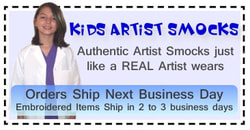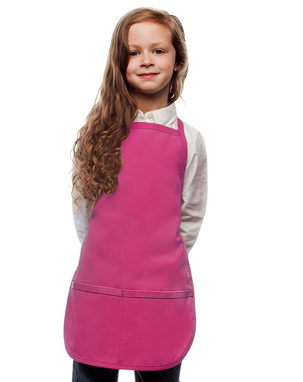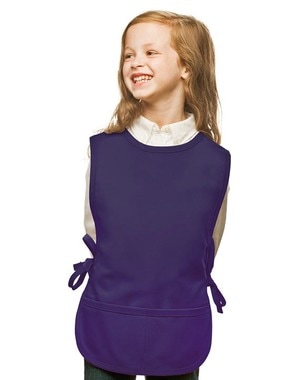Kids Art Smocks Pave the Way to Increased Creativity

Creativity can be messy, but kids artist smocks let parents and teachers relax and leave children free to create. Art helps children learn far more than drawing and coloring. Through art, they develop analytical and problem-solving skills, learn basic math, and get a boost in self-confidence. Encouraging children to draw and experiment prepares them for greater academic challenges later on. Successful creativity can be encouraged through preparation, opportunity, and conversation by and with parents and teachers.
Preparation
Many a promising art project has fallen flat because of a lack of preparation. Success begins by preparing for a mess. Whether it's paints or crayons, kids find a way to wear their art. Cover clothing with kids artist smocks to give parents peace of mind and children the freedom to wipe fingers, splatter paint, or bump into other artists. Little artists aren't the only ones that need protection. Lay down newspaper or a drop cloth under the art project to protect surfaces. With everyone and everything safely covered, all it takes are materials and imagination.
Opportunity to Experiment
Once the materials are there, it's time to stand back and let kids create unhindered by outside rules. When children have the opportunity to experiment with art they discover color, line, and hue on their own without having to be told. Open exploration encouraged by parents and teachers lets children discover solutions independently. While they are experimenting, they can learn other valuable skills like basic math as they count their brushes or the number of colors they've used. Mixing paint teaches them to problem solve when they have to make purple with only red and blue paint.
Conversation
Asking questions about art helps children analyze what they've made. They also learn to talk about what they've done and explain their process. Asking questions like, "Can you tell me about what you drew?" gives children an opportunity to organize thoughts, talk about color, line, or what they imagine the world being like. Compliments may feel good, but they don't necessarily encourage children to think deeper. Asking questions about patterns or colors the child used allows them to analyze their own work.
Art is a powerful tool for learning. With the right supplies, questions, and encouragement it can become a way for children to improve academic performance through a creative activity.
Preparation
Many a promising art project has fallen flat because of a lack of preparation. Success begins by preparing for a mess. Whether it's paints or crayons, kids find a way to wear their art. Cover clothing with kids artist smocks to give parents peace of mind and children the freedom to wipe fingers, splatter paint, or bump into other artists. Little artists aren't the only ones that need protection. Lay down newspaper or a drop cloth under the art project to protect surfaces. With everyone and everything safely covered, all it takes are materials and imagination.
Opportunity to Experiment
Once the materials are there, it's time to stand back and let kids create unhindered by outside rules. When children have the opportunity to experiment with art they discover color, line, and hue on their own without having to be told. Open exploration encouraged by parents and teachers lets children discover solutions independently. While they are experimenting, they can learn other valuable skills like basic math as they count their brushes or the number of colors they've used. Mixing paint teaches them to problem solve when they have to make purple with only red and blue paint.
Conversation
Asking questions about art helps children analyze what they've made. They also learn to talk about what they've done and explain their process. Asking questions like, "Can you tell me about what you drew?" gives children an opportunity to organize thoughts, talk about color, line, or what they imagine the world being like. Compliments may feel good, but they don't necessarily encourage children to think deeper. Asking questions about patterns or colors the child used allows them to analyze their own work.
Art is a powerful tool for learning. With the right supplies, questions, and encouragement it can become a way for children to improve academic performance through a creative activity.
|
Kids Art Smock
Bib Style |
Kids Art Smock
Cobbler Style |
Kids Art Smock
Traditional Lab Coat Style |











